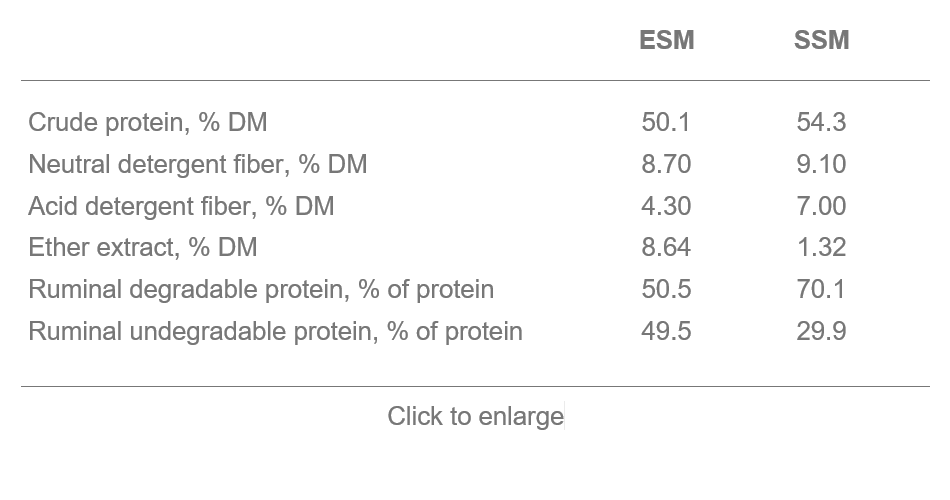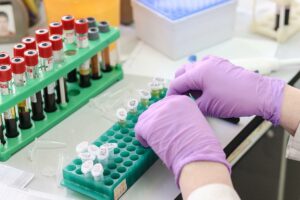Andrés Haro & Fernando Diaz
The use of extruded soybeans (ESM) has been adopted by dairy farms because of high nutritional value. It is an excellent source of protein, and particularly high in the essential amino acid lysine. Solvent-extracted soybean meal (SSM) has quite a stable nutrient composition (view table), with higher protein concentration (54.3% DM) and lower in fat (1.3% DM), compared to the ESM (50.1% protein and 8.7% fat). In addition, ESM has higher bypass protein content of 49.5% whereas SSM has only 29.9%.
 A study conducted in Pennsylvania (Harper et al., 2019) evaluated the productive and reproductive response of cows in early lactation fed diets that included 12% ESM or SSM. The study included 34 fresh Holstein cows (primiparous and multiparous) up to 60 days postpartum, distributed in a randomized complete block design that received two similar diets, which only differed in their inclusion of soybean meal. The diets contained 18.3 and 18.7% of crude protein, and 4.5 and 3.6% of fat for ESM and SSM, respectively. Of this fat, 72 and 11% came from ESM and SSM respectively. During the trial dry matter intake, milk production and composition, fatty acids, plasma metabolites and reproductive activity were recorded.
A study conducted in Pennsylvania (Harper et al., 2019) evaluated the productive and reproductive response of cows in early lactation fed diets that included 12% ESM or SSM. The study included 34 fresh Holstein cows (primiparous and multiparous) up to 60 days postpartum, distributed in a randomized complete block design that received two similar diets, which only differed in their inclusion of soybean meal. The diets contained 18.3 and 18.7% of crude protein, and 4.5 and 3.6% of fat for ESM and SSM, respectively. Of this fat, 72 and 11% came from ESM and SSM respectively. During the trial dry matter intake, milk production and composition, fatty acids, plasma metabolites and reproductive activity were recorded.
The inclusion of ESM did not affect diet palatability, and as a result DM intake was not affected by soybean source (21.7 kg/d). Milk production was similar for both the ESM and SSM treatments (42.5 kg/d), with no difference in milk fat and protein concentration (4.00% and 2.88%, respectively).
The total proportions of saturated fatty acids (FA) in the milk of cows fed SSM was higher than those fed ESM. However, total monounsaturated FA and polyunsaturated FA in milk were increased by 6.3% when ESM was included in the diets, a reflection of the higher fat concentration in this product.
Starch and fiber (NDF) intakes were similar for both diets, there was however a higher protein intake (4.79 kg/d) in cows fed diets containing SSM compared to those that included ESM (4.41kg/d). In addition, the apparent digestibility was not affected in any of the two diets. Plasma amino acid concentrations increased (leucine, valine and phenylalanine) in diets containing ESM compared to those with SSM, this was likely associated to the highest RUP of ESM (49.5% protein) vs. that in SSM (29.9% protein).
The return to ovarian cyclic activity was not different between both ESM and SSM fed groups, with an average duration of the luteal phase of 32.7 days, and an average interval to the second luteal phase of 45.2 days for both treatment groups.
In conclusion, the substitution of solvent-extracted soybean meal for extruded soybean meal is an alternative for feeding dairy cows in early lactation due to their high energy and protein contribution. It can totally replace other soybean meal sources in the diet without negatively affecting the cows productive and reproductive performance.
Reference:
Harper, M.T., Oh, J., Melgar, A., Nedelkov, K., Räisänen, S., Chen, X., … Fabin, R.A. 2019. Production effects of feeding extruded soybean meal to early-lactation dairy cows. Journal of Dairy Science. 102: 8999-9016.
© 2020 Dairy Knowledge Center. All Rights Reserved.











